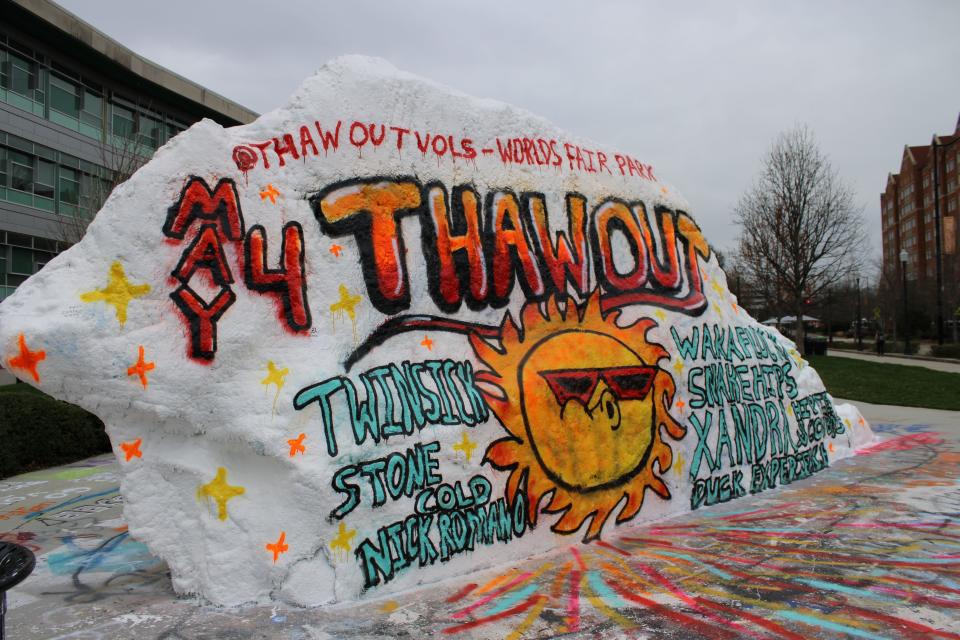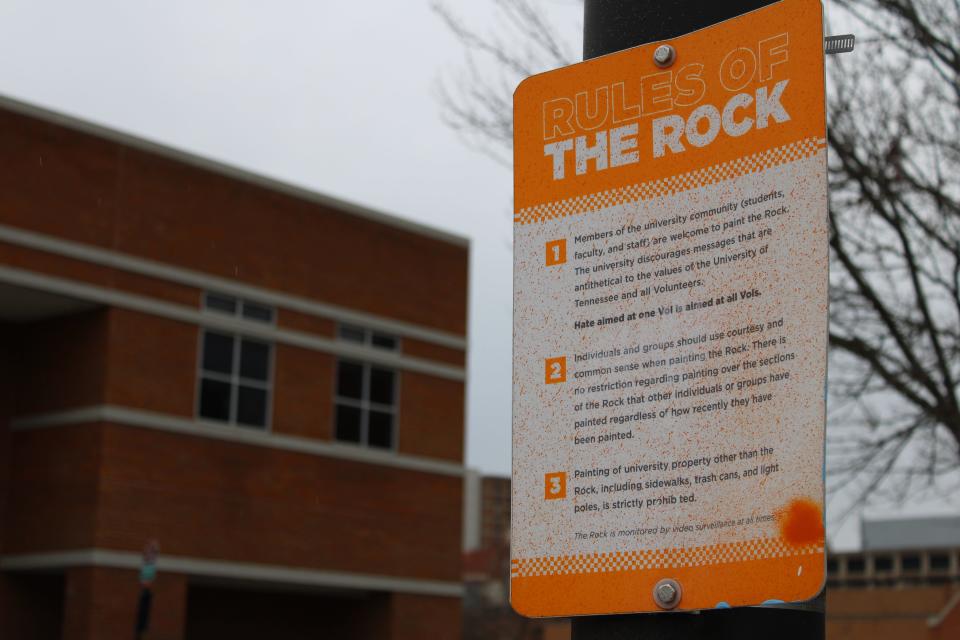Why does the University of Tennessee livestream The Rock? | Know Your Knox
One corner of the University of Tennessee campus in Knoxville has cameras pointed at it at all times, livestreaming anything that happens there 24/7. The UT Police Department patrols the area. A student group monitors the corner.
All eyes focus on one thing: a giant rock.
But why is a rock the focus of such scrutiny on the UT campus?
Well, it's not just any rock. It's the Rock, a monument to free speech on campus.
Two cameras livestream the Rock, located on the corner of Pat Head Summitt Street and Volunteer Boulevard. Anyone can see what message is on the Rock or who's painting a new one in real time.
Students equipped with spray paint, brushes, paint cans and ladders routinely paint on the popular monument as a community message board. Here's how it came to be under such round-the-clock supervision.

How long has the Rock been at the University of Tennessee?
UT unearthed the Rock in 1966 after the university acquired the land used by Calvary Baptist Church, which is now the location of the UT Student Health Center building. Previously, only a small chunk of the now famous and towering rock protruded from the dirt.
The university considered several names for the campus favorite - Kissing Rock, the Fellowship Stone, the Volunteer Image - before settling on the simple, yet aptly descriptive name "the Rock." In the 1980s, students began graffitiing the Rock, The Daily Beacon reported in 2009. UT attempted to keep the Rock clean, but ultimately decided to let students keep painting it.

In 2009, the Rock took a trip across the street when UT moved the 97.5-ton hunk of Knox dolomite 275 feet to its current location to make way for the UT Student Health Center.
Several layers of paint oozed off the Rock in 2015 during the hot summer, which left the poor canvas nearly naked for the first time in decades.
UT celebrated the Rock's 50th "birthday" in 2016, a flattering age considering professor Bill Dunne estimates the ginormous stone is about 500 million years old.
Now the Rock serves as a symbol of student free speech on campus, with UT encouraging students to paint messages on it.
Why does the University of Tennessee livestream the Rock?
Hate speech has been painted on the Rock several times, prompting UT to take action to prevent it from happening again.
UT installed the cameras in 2019 after several incidents were reported. Chancellor Donde Plowman issued a statement announcing the cameras, plus more patrols from the UT Police Department to monitor the Rock.
UT doesn't record the livestream, however, according to the livestream webpage. Plowman's statement said the livestream is a "symbol that our community is taking collective responsibility for the Rock." UT encourages students to take action against messages they disagree with by painting over hateful or harmful messages.
At the same time, the group Students for the Rock formed to encourage people to paint the Rock, to protect First Amendment rights and to patrol the Rock to fight defamatory or discriminatory messages.

UT asks students to report incidents occurring at the Rock but not to confront anyone. For emergencies, students can call the UTPD at 865-974-3111 or dial 911. Students can make nonemergency calls to 865-974-3114. Students can also use the LiveSafe app on their phones to report incidents.
So check the livestream to see what's on the Rock - or if you've got something to say, head that way with some paint.
Know Your Knox answers your burning questions about life in Knoxville. Want your question answered? Email [email protected].
Keenan Thomas is a higher education reporter. Email [email protected]. X, formerly known as Twitter @specialk2real.
Support strong local journalism by subscribing to knoxnews.com/subscribe.
MORE QUESTIONS ANSWERED BY KNOW YOUR KNOX
Are bodies really buried beneath Neyland Stadium?
When you watch the movie "The Blind Side," you might sit up and take notice when Kathy Bates' character declares that the University of Tennessee stores body parts "right underneath the football field" in connection with UT's study of the decomposition of dead bodies. For anyone haunted by that thought when sitting in Neyland Stadium, Ryan Wilusz gets at the truth of this persistent claim.
Why are the University of Tennessee Vols' colors orange and white?
Buildings, vehicles, clothes and even food around Knoxville all pay tribute to Big Orange every day of the year, it seems, and even more so on game days. But where did the color combination of bright orange and white for the University of Tennessee Volunteers come from? Liz Kellar follows traces the daisy chain of this UT tradition (that's a hint!) back to the beginning.
Why was the University of Tennessee System created?
Though it seems like it's been around forever, the web that connects universities across Tennessee wasn't formed until 1968. That's just the blink of an eye when you consider the University of Tennessee at Knoxville was founded in 1794. Keenan Thomas dives into why the scattered universities were linked and what it's meant for Vols statewide.
What’s the right way to say Vols?
There’s one, and only one, way to say the nickname of the University of Tennessee football team that plays in Neyland Stadium. It might seem obvious to any Southern football fan, but newcomers jumping on the Volunteers bandwagon can be understood - if perhaps not forgiven - for not getting it quite right on their first try. Never fear; Adam Sparks comes to the rescue.
This article originally appeared on Knoxville News Sentinel: The Rock at the University of Tennessee has a livestream. Here's why
